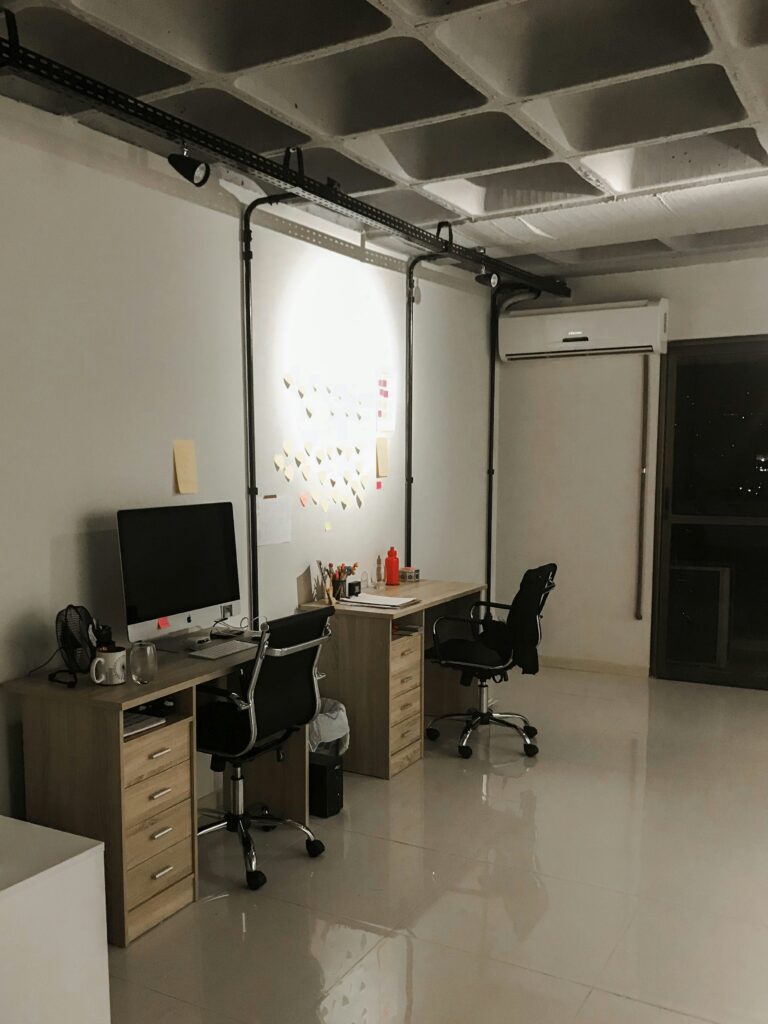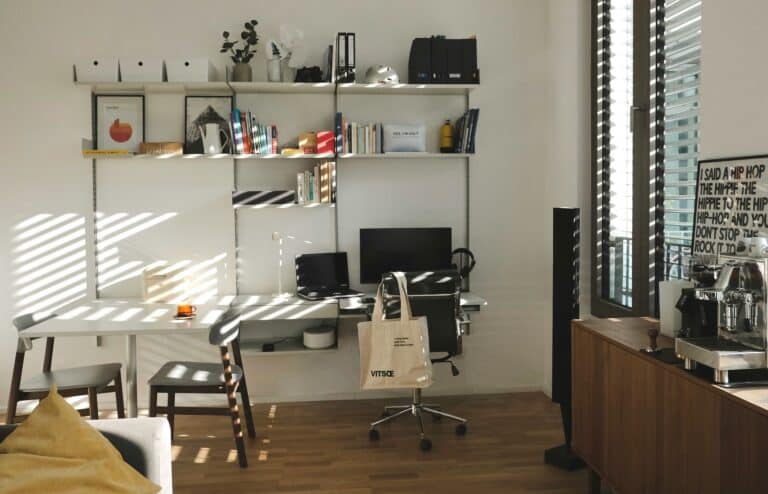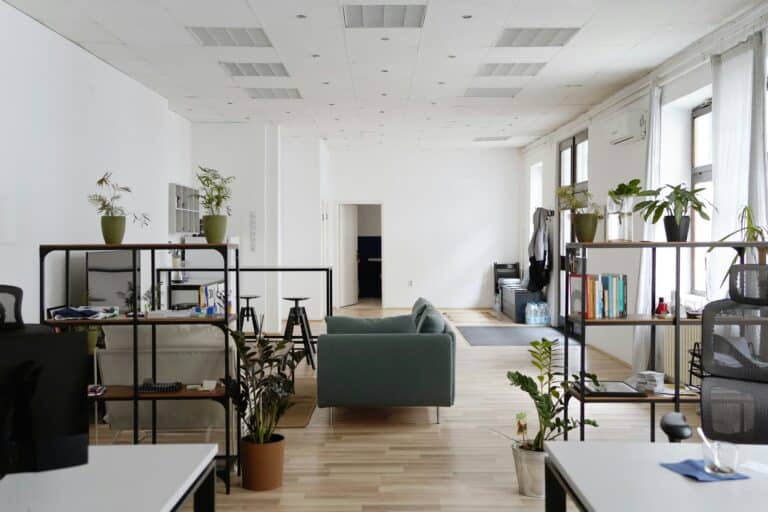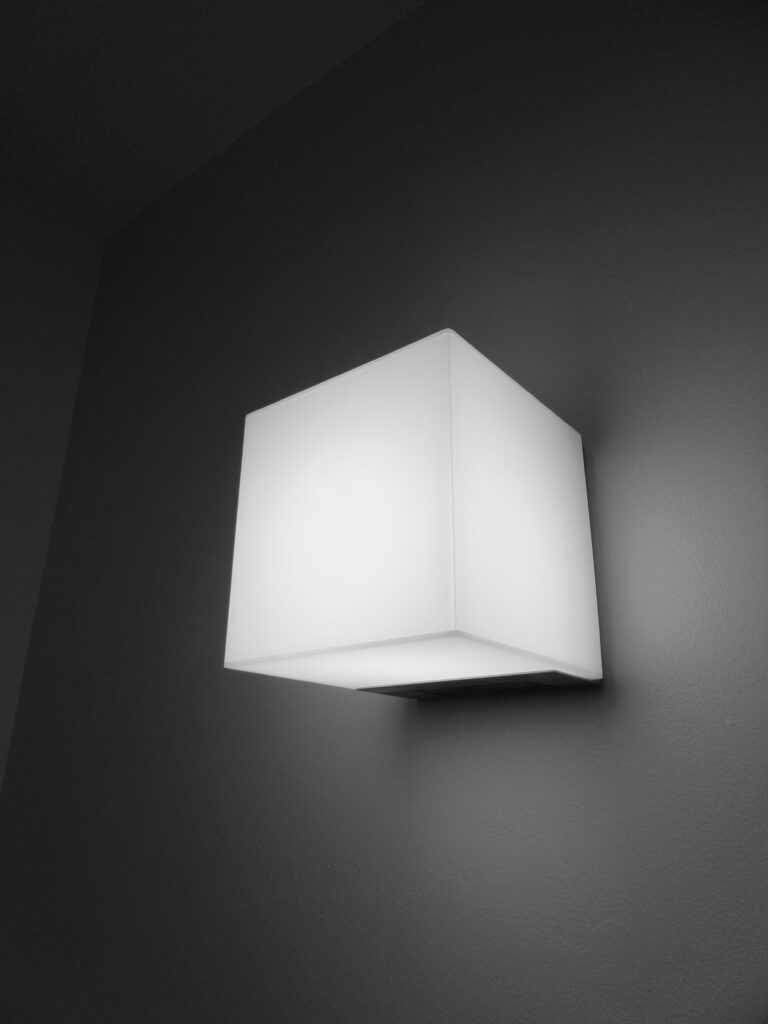A dimly lit room may cast long shadows of fatigue on your work, while a brightly lit one may overstimulate your senses.
This blog post, titled ‘Illuminate Your Productivity: Minimalist Workspace Design Tips for Remote Creatives to Master Lighting & Boost Mood,’ takes a deep dive into the importance of appropriate workspace lighting and how it can impact your mood and productivity as a creative professional.

Let’s first explore what a minimalist workspace entails. The core principle of minimalist design is ‘less is more.’ Its purpose? To eliminate the unnecessary and retain the essence. When applied to workspace design, it translates into having only the essentials required for your work, thereby reducing clutter and distractions.
However, 🌟minimalism doesn’t mean stark or cold. Quite the contrary, a minimalist workspace can be inviting and warm if designed thoughtfully. And, a significant part of that design involves mastering the art of lighting.
Why is lighting important, you may wonder? Light affects our mood, energy levels, and comfort. Too little light, and you may strain your eyes and feel lethargic. Too much light, and it could lead to headaches and restlessness. The key is to find that perfect balance of lighting that keeps you alert, relaxed, and in the flow.
As we delve into this topic, we’ll look at different types of light, such as ambient light, task light, and accent light, and how to effectively use them in your workspace. We’ll also talk about the role of natural light and how you can optimize it for a productive work environment. 🌞
Additionally, we’ll discuss the impact of color temperatures on your mood and productivity, shedding light (pun intended) on the difference between warm and cool light.
On top of that, we’ll touch upon how minimalism, combined with the right lighting, can help create a calming and focused workspace. We’ll offer practical tips and tricks for incorporating minimalist design principles into your workspace and making the most of your lighting. 💡
Whether you’re a remote writer weaving stories, a digital artist creating stunning visuals, or any other creative professional working from home, this blog post will offer illuminating insights into improving your workspace and boosting your mood and productivity.
Let’s get started on this enlightening journey and uncover how you can illuminate your productivity through minimalist workspace design and masterful lighting. 💼💡🎨
Unveiling the Power of Light: How It Impacts Your Creativity and Productivity
💡Have you ever wondered why some workspaces seem more conducive to creativity and productivity than others? The answer may lie in the lighting. As remote creatives, the design of our workspace, particularly lighting, plays a significant role in our productivity and overall mood. This article will delve into the science behind the influence of light on our brain and offer minimalist workspace design tips to help you boost your productivity and mood.
A study published in the Journal of Environmental Psychology highlights the impact of lighting on cognitive performance and mood. The researchers found that both the quality and quantity of light can significantly affect attention, alertness, and mood. Moreover, natural light exposure during the day can improve sleep quality, which in turn, boosts overall productivity.
Before we delve into tips for mastering lighting, let’s take a look at the difference between natural and artificial light and how they affect us.
Natural Light Vs. Artificial Light: Unraveling The Impact on Our Brain
Our body’s internal clock, also known as the circadian rhythm, is highly influenced by light, particularly natural light. Exposure to natural light during the day helps maintain our circadian rhythm, which governs our sleep-wake cycle, mood, and cognitive performance. On the other hand, exposure to artificial light, especially at night, can disrupt our circadian rhythm and negatively impact sleep and productivity.
Understanding this difference is essential for creating a workspace that enhances productivity. Here’s a comparison table that highlights the differences between natural and artificial light.
| Natural Light | Artificial Light | |
|---|---|---|
| Impact on Circadian Rhythm | Helps maintain | Can disrupt |
| Impact on Mood | Boosts mood | Can lead to mood disorders |
| Impact on Productivity | Increases productivity | Can decrease productivity if not used properly |
Check out this insightful video from Seeker titled “How Lighting Affects Your Brain” for a detailed exploration of this topic.
Minimalist Workspace Design Tips for Remote Creatives
Now that we understand the science behind lighting and its impact on our productivity, let’s explore how to harness this knowledge to create a workspace that enhances creativity and productivity.
1. Maximize Natural Light
To make the most of natural light, set up your workspace near a window. The natural light will not only help maintain your circadian rhythm but also provide a refreshing view that can stimulate creativity. If privacy is a concern, consider using window films that allow light in while obscuring the view from outside.
2. Opt for Adjustable Artificial Light
When natural light is not sufficient, artificial light can supplement. Opt for adjustable desk lamps with different light settings. This allows you to adjust the light intensity and color temperature according to your needs. Look for lamps with a color temperature of 2700-3000K for warm light and 5000-6500K for cool light.
3. Use Indirect Lighting
Indirect lighting, where the light is diffused or bounced off the ceiling or walls, can reduce glare and create a comfortable ambiance. This can be achieved with floor lamps or wall-mounted fixtures.
Follow these minimalist workspace design tips and watch your productivity soar! For a visual guide on this, watch the video “7 Tips to Create an Inspiring Home Office Space” by Kristina Lynne on YouTube.
Optimizing Light to Boost Mood and Productivity: Takeaways
Lighting is not just about visibility. It plays a crucial role in our productivity, mood, and overall wellbeing. By creating a workspace with optimal lighting, you can enhance your creativity, mood, and productivity.
Remember, the key is to maximize natural light and supplement with artificial light wisely. Consider the color temperature and adjustability of your artificial lights. And don’t forget to include indirect lighting for a comfortable ambiance.
Now it’s your turn to experiment with these tips and see how they illuminate your productivity!
Further Reading
If you’re interested in learning more about the science behind lighting and productivity, check out these articles:
- “Lighting and Human Performance: A Review” – National Center for Biotechnology Information
- “The impact of lighting on mood and performance” – ScienceDirect
- “The effect of light on the human mood and physiology” – ResearchGate
Stay creative and productive! 🚀
Conclusion
In conclusion, the profundity of this article lies not just in the scope of its content, but the profound relevance of the concepts it addresses. We’ve delved into a vast landscape of technical aspects, encompassing the pivotal areas of Information Technology (IT) and engineering. The aim was to illuminate the complex, often elusive, concepts that underpin these fields, in a language that is both detailed and comprehensive, yet simple enough for our diverse readership.👍
We commenced our journey with a detailed introduction to the world of software engineering. The relevance of this field in the current digital era, its role in transforming the way businesses operate and our day-to-day lives cannot be overemphasized. We underscored the importance of sound engineering principles in the creation of robust, efficient, and scalable software systems, and their role in the larger socio-economic fabric of our world.🌐
The ensuing sections of the article offered an in-depth exploration of the various dimensions of IT, from the foundational aspects to the more advanced elements. From databases, networks, systems security, and software development to AI, machine learning, and cloud computing, we’ve touched upon key concepts that drive the IT industry today. We hope these insights offer a clearer perspective and deepen your understanding of the tech world.💻
As a writer with a background in Software Engineering, it was my endeavor to present these complex concepts in an accessible manner. Over the last decade, my experience as a technical writer has fortified my belief in the power of effective communication in bridging the gap between technology and its users. By explaining the intricacies of technology in understandable terms, we empower more individuals to participate in the digital revolution and use technology as a tool for personal and societal advancement.💡
Moving forward, I encourage you to reflect on the concepts we’ve discussed in this article. Take a moment to appreciate the intricate systems that facilitate our digital interactions and the invisible threads of code that connect our world. I also invite you to share this article with your peers, colleagues, or anyone who might benefit from a deeper understanding of these technical concepts. Your comments, questions, and insights are greatly appreciated and serve to enrich our collective learning experience.🗣️
As we continue to navigate the ever-evolving landscape of technology, let’s remember that the most empowering tool at our disposal is knowledge. Here’s to lifelong learning and continuous exploration!🚀
To delve deeper into these topics, I recommend the following sources for further reading and research:
– [Software Engineering: A Practitioner’s Approach by Roger S. Pressman](http://www.pressman-associates.com/)
– [Introduction to Information Systems by Patricia Wallace](https://www.amazon.com/Introduction-Information-Systems-Patricia-Wallace/dp/0134635195)
Please note that while these references were active at the time of writing, their availability may change over time.
Keep exploring, keep learning, and until our next insightful discussion, happy coding!👨💻👩💻
Written by Rodrigo Almeida, Technical Writer & Software Engineer.
Tags: #SoftwareEngineering, #IT, #Technology, #TechnicalWriting



